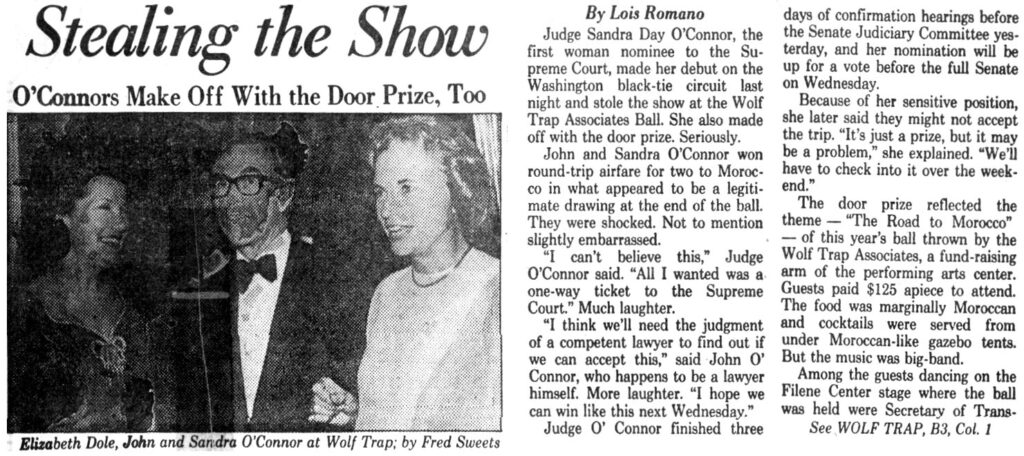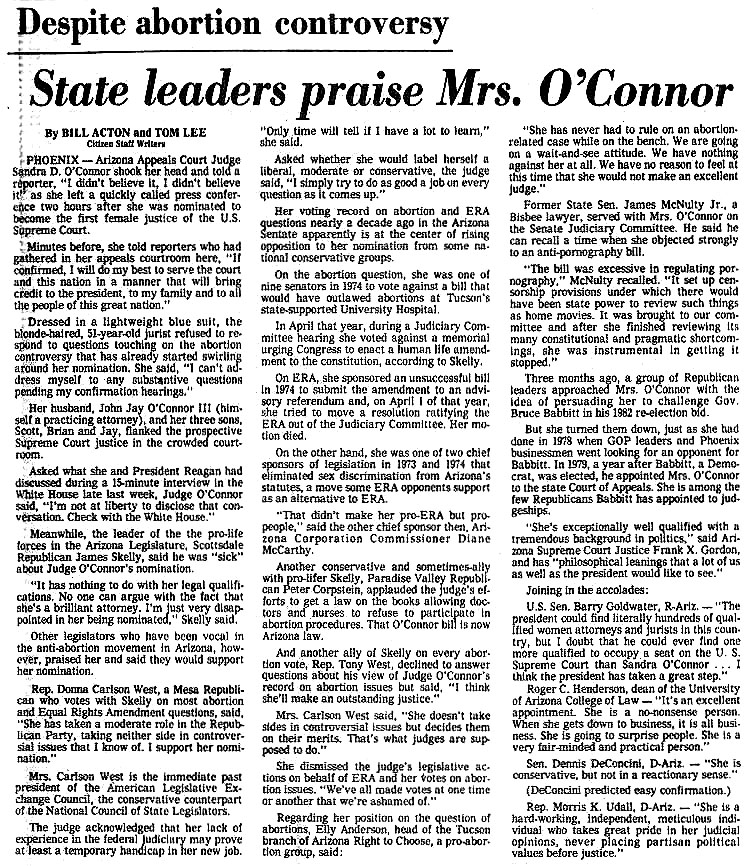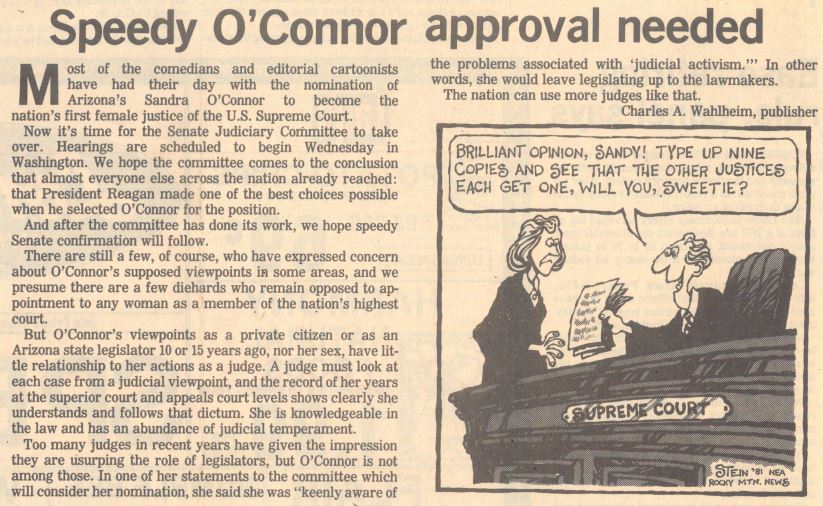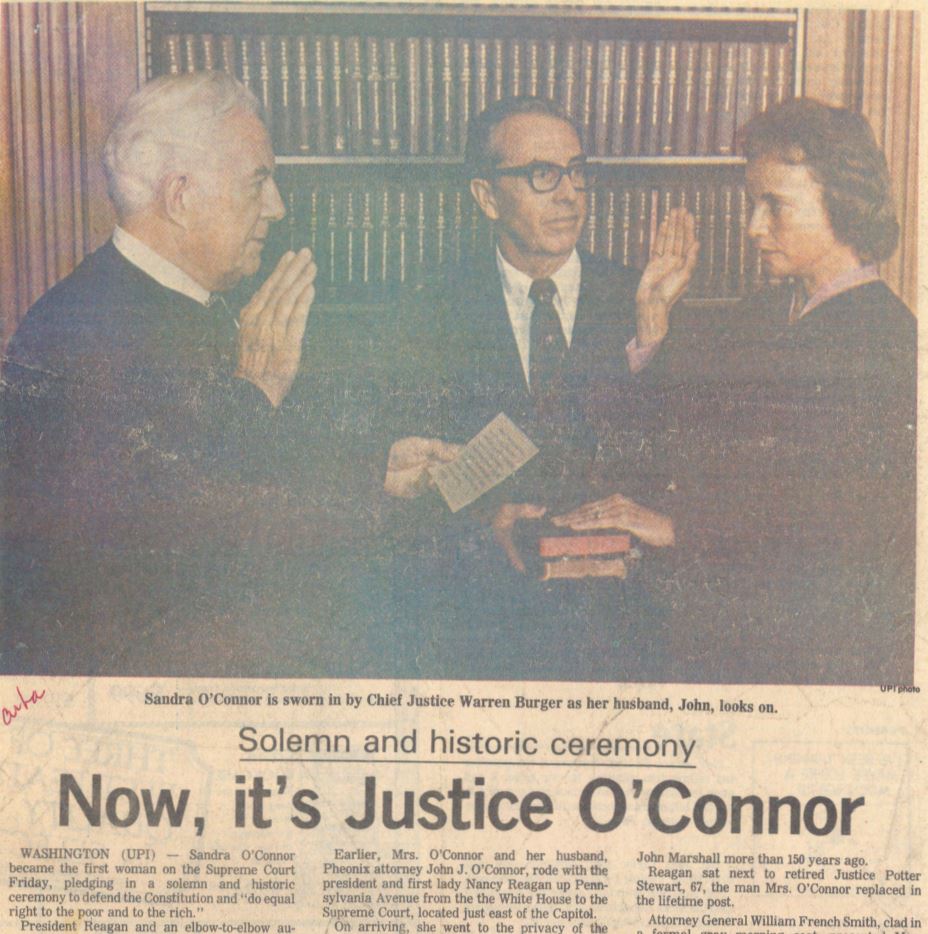Stealing the Show
O’Connors Make Off With the Door Prize, Too Judge Sandra Day O’Connor, the first woman nominee to the Supreme Court, made her debut on the Washington black-tie circuit last night and stole the show at the Wolf Trap Associates Ball. She also made off with the door prize. Seriously. John and Sandra O’Connor won round-trip airfare for two to Morocco in what appeared to be a legitimate drawing at the end of the ball. They were shocked. Not to mention slightly embarrassed. “I can’t believe this,” Judge O’Connor said. “All I wanted was a one-way ticket to the Supreme Court.” Much laughter. “I think we’ll need the judgment of a competent lawyer to find out if we can accept this,” said John O’Connor, who happens to be a lawyer himself. More laughter. “I hope we can win like this next Wednesday.” Judge O’Connor finished three days of confirmation hearings before the Senate Judiciary Committee yesterday, and her nomination will be up for a vote before the full Senate on Wednesday. Because of her sensitive position, she later said they might not accept the trip. “It’s just a prize, but it may be a problem,” she explained. “We’ll have to check into it over the weekend.” The door prize reflected the theme – “The Road to Morocco” – of this year’s ball thrown by the Wolf Trap Associates, a fund-raising arm of the performing arts center. Guests paid $125 apiece to attend. The food was marginally Moroccan and cocktails were served from under Moroccan-like gazebo tents. But the music was big-band.
States forbidden to tax newspapers’ ink, paper
States cannot tax the paper and ink used in publishing newspapers, the Supreme Court ruled today. By an 8-1 vote, the Justices struck down such a Minnesota tax as unconstitutional. Writing for the court, Justice Sandra Day O’Connor said the tax violates free-press rights protected by the Constitution’s First Amendment. “Differential taxation of the press places such a burden on the interests protected by the First Amendment that we cannot countenance such treatment unless the state asserts a counterbalancing interest of compelling importance that it cannot achieve without differential taxation,” O’Connor said. She said Minnesota authorities had produced no sue ‘compelling” interest. Minnesota’s “use” tax was levied only on ink and paper used by publishers. Other businesses that use thos products were not subject to the Non-publishers pay a state retail sales tax on goods they produce, and publishers are exempt from that sales tax. The _tax was challenged in 1975 by The Minneapolis Star and Tribune Co., which at the time published The Minneapolis Tribune and The Minneapolis Star newspapers. Last year, the Star was merged with the Tribune and ceased to exist as a separate paper. For a 17-month period beginning Jan. 1, 1974 the publishing company paid $874,265.04 in taxes on the ink and paper it consumed. Its suit sought a refund of that money and a halt to further imposition of the tax. Today’s Supreme Court ruling means the publishing company will receive its sought-after refund
State senators recall O’Connor as even-handed, a perfectionist
PHOENIX – Supreme Court Justicedesignate Sandra O’Connor was depicted yesterday by former legislative colleagues as a perfectionist who often was frustrated with t.be lawmaking process when she served in the Arizona Senate. But she also was fair, intelligent, brilliant, terrific, thoughtful, moderately conservative, rational, gracious and “a great gal,” according to those who know her. The consensus of her former colleagues was that her perfectionism will serve her well on the Supreme Court. O’Connor herself, at a morning news conference in a jampacked Court of Appeals courtroom, was nearly silent, staying completely away from discussing such substantive issues as her stands on the Equal Rights Amendment and abortion. Protectively watched by a White House deputy press secretary, O’Connor said that to answer substantive questions before reporters would “pre-empt the confirmation process before the (U.S.) Senate.” She read a two-sentence statement saying she was honored to have been chosen and pledging to “do my best to serve the court and this nation in a manner that will bring credit to the president, to my family and to all the people of this great nation.” O’Connor appeared at the news conference with her husband, John Jay O’Connor III, a prominent Phoenix attorney, and her three sons, Scott, 23, Brian, 21, and Jay, 19. At the conclus!on of her short state- ment, her judicial colleagues and the employees of the Court of Appeals broke into sustained applause. In the state Senate,
State Leaders praise Mrs. O’Connor
PHOENIX – Arizona Appeals Court Judge Sandra D. O’Connor shook her head and told a r~rter, “I didn’t believe It, I didn’t believe it’ as she left a quickly called press confere(lce two hours after she was nominated to become the first female justice of the U.S. Supreme Court. Minutes before, she told reporters who had gathered in her appeals courtroom here, “If confirmed, I will do my best to serve the court and this nation in a manner that will bring credit to the president, to my family and to all the people of this great nation.” Dressed in a lightweight blue suit, the blonde-haired, 51-year-old jurist refused to respond to questions touching on the abortion controversy that has already started swirling around her nomination. She said, “l can’t address myself to any substantive questions pending my confirmation hearings.” Her husband, John Jay O’Connor III (himself a practicing attorney), and her three sons, Scott, Brian and Jay, flanked the prospective Supreme Court justice In the crowded courtroom. Asked what she and President Reagan had discussed during a !~minute interview in the White House late last week, Judge O’Connor said, “I’m not at liberty to disclose that conversation. Check with the White House.” Meanwhile, the leader of the the pro-life forces in the Arizona Legislature, Scottsdale Republican James Skelly, said he was “sick” about Judge O’Connor’s nomination. “It has nothing to do with her legal qualifications. No one can argue with the fact that she’s a brilliant
Stanford Classmate Remembers O’Connor as ‘Complete Person’
STANFORD, Calif. (UPI) – A Stanford classmate of Sandra Day O’Connor, President Reagan’s nominee for the U.S. Supreme Court, remembers her as “a complete person, interested in everything.” Mrs. O’Connor received her bachelor’s degree in economics from Stanford in 1950 and her law degree in 1952, ranking third in a class in which Supreme Court Justice William Rehnquist was first. She met her future husband, John Jay O’Connor III, a 1951 graduate of Stanford, on the school’s prestigious Law Review board of editors. And she was elected to serve as a trustee of the university from 1976 to 1980. San Francisco attorney Atherton Phleger, a fellow law student, said he remembered her brilliance and the fact that she never isolated herself from anything. ” She was a complete person, interested in everything and not cloistered,” Phleger said. Stanford President Donald Kennedy said, “We’re very proud of her.” “It’s a superb appointment,” Stanford Law School Dean Charles Meyer said. “She’s a woman of great ability, tremendous balance and good political understanding .” Mrs. O’Connor went to work in the district attorney ‘s office in San Mateo County, Calif., after she graduated from law school, first as a law clerk and later as an assistant district attorney working in civil law. She went on to win election to the Arizona state Senate, becoming the first woman in the nation to serve as a majority leader in a state legislature, was elected a Superior Court judge and was appointed to the Arizona
Speedy O’Connor approval needed
Most of the comedians and editorial cartoonists have had their day with the nomination of Arizona’s Sandra O’Connor to become the nation’s first female justice of the U.S. Supreme Court.
Now it’s time for the Senate Judiciary Committee to take over. Hearings are scheduled to begin Wednesday in Washington. We hope the committee comes to the conclusion that almost everyone else across the nation already reached: that President Reagan made one of the best choices possible when he selected O’Connor for the position. And after the committee has done its work, we hope speedy Senate confirmation will follow. There are still a few, of course, who have expressed concern about O’Connor’s supposed viewpoints in some areas, and we presume there are a few diehards who remain opposed to appointment to any woman as a ‘member of the nation’s highest court. But O’Connor’s viewpoints as a privat e citizen or as an Arizona state legislator 10 or 15 years ago, nor her sex, have little relationship to her actions as a judge. A judge must look at each case from a judicial viewpoint, and the record of her years at the superior court and appeals court levels shows clearly she understands and follows that dictum. She is knowledgeable in the law and has an abundance of judicial temperament . Too many judges in recent years have given the impress ion they are usurping the role of legislators, but O’Conn.or is not among those. In one of her statements to the committee which will consider her nomination,
Solemn and historic ceremony: Now, it’s Justice O’Connor
WASHING TON (UPI) – Sandra O’Connor became the first woman on the Supreme Court Friday, pledging in a solemn and historic ceremony to defend the Constitution and “do equal right t? the ~r and to the rich.” President Reagan and an elbow-to-elbow audience of 400 people jamme~ the courtroom to watch Chief Justice Warren Burger swear in the Mrs. O’Connor as an associate justice of the nation’s highest court . “Justice O’Connor, welcome to the court,” Burger said at the conclusion of the oath. “I wish you a long life and a long and happy career in our common calling.” Earlier, Mrs. O’Connor and her husband, Pheonix attorney John J . O’Connor, rode with the president and first lady Nancy Reagan up PeMsylvania Avenue from the the White House to the Supreme Court, located just east of the Capitol. , On arriving, she went to the privacy of the . ~ustices’ oak-paneled conference room, where the j shf took a Judicial Oath from Burger. There she pledged, in part, ‘i~~P.f. justice without ~ spect to p~nmns, and do equal right to 1:/1! 911or I.Ind to fl)~ nch.” A Sl)ecial session of the high court followed, COrunencing – as always – with the sharp rap of tile gavel by Court Marshal Alfred Wong and the entrance of the black -robed justices. John Marshall more than 150 years ago. Reagan sat next to retired Justice Potter Stewart, 67, the man Mrs. O’Connor replaced in the lifetime post. Attorney General William French Smith , clad in a formal gray morning coat, presented Mrs . O’Connor’s commission




